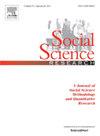Arbitrage equilibrium in scale- and venue-mediated socioeconomic segregation: A behavioral microeconomics framework
IF 3.5
2区 社会学
Q1 SOCIOLOGY
引用次数: 0
Abstract
Contrary to the widely believed hypothesis that larger, denser cities promote socioeconomic mixing, a recent study reports the opposite behavior, i.e. more segregation. We present a behavioral microeconomics framework that predicts such segregation in multiclass systems. In our framework, every agent tries to maximize its effective utility, a measure of its socioeconomic benefit–cost trade-offs, by making choices about where to live and socialize. Our effective utility model incorporates well-known behavioral elements, such as homophily, congestion costs, venue option benefit, competition costs, and exploration vs. exploitation strategies. We prove that a population of such socioeconomic agents will reach an arbitrage equilibrium under certain general conditions. We derive the mathematical conditions that lead to social segregation. Our theory presents a micro-to-macro mathematical framework that connects individual preferences to neighborhood-level outcomes.
Our key insight is that socioeconomic segregation mechanisms operate differently at different population densities. In low-density environments, agents accept more socioeconomic diversity due to reduced homophily benefits. In high-density environments, the abundance of people and choices enables finer-grained sorting by socioeconomic traits. Furthermore, the arbitrage equilibrium outcome implies the equality of effective utilities among all agents. This intriguing result could be interpreted as all agents being equally “happy” in their respective environments, despite segregation, in our ideal society. This captures the essence of Rawlsian distributive justice and fairness. Our theory contributes towards a deeper philosophical and mathematical understanding of socioeconomic dynamics and behavior as we strive to create more harmonious societies.
规模和场所中介的社会经济隔离中的套利均衡:行为微观经济学框架
与人们普遍认为的更大、更密集的城市促进社会经济混合的假设相反,最近的一项研究报告了相反的行为,即更多的隔离。我们提出了一个行为微观经济学框架来预测多阶级系统中的这种隔离。在我们的框架中,每个主体都试图通过选择在哪里生活和社交来最大化其有效效用,这是衡量其社会经济效益-成本权衡的指标。本实用新型结合了众所周知的行为要素,如同质性、拥堵成本、场地选择效益、竞争成本以及探索与开发策略。我们证明了在一定的一般条件下,这样的社会经济主体群体将达到套利均衡。我们推导出导致社会隔离的数学条件。我们的理论提出了一个微观到宏观的数学框架,将个人偏好与社区水平的结果联系起来。我们的关键观点是,社会经济隔离机制在不同的人口密度下运作不同。在低密度环境中,由于同质性利益的减少,代理人接受更多的社会经济多样性。在高密度的环境中,丰富的人口和选择可以根据社会经济特征进行更细粒度的分类。此外,套利均衡结果意味着所有主体的有效效用相等。这个有趣的结果可以解释为,在我们理想的社会中,尽管存在种族隔离,但所有参与者在各自的环境中都同样“快乐”。这抓住了罗尔斯分配正义和公平的本质。我们的理论有助于在我们努力创造更和谐社会的同时,对社会经济动态和行为有更深层次的哲学和数学理解。
本文章由计算机程序翻译,如有差异,请以英文原文为准。
求助全文
约1分钟内获得全文
求助全文
来源期刊

Social Science Research
SOCIOLOGY-
CiteScore
4.30
自引率
4.00%
发文量
0
审稿时长
65 days
期刊介绍:
Social Science Research publishes papers devoted to quantitative social science research and methodology. The journal features articles that illustrate the use of quantitative methods in the empirical solution of substantive problems, and emphasizes those concerned with issues or methods that cut across traditional disciplinary lines. Special attention is given to methods that have been used by only one particular social science discipline, but that may have application to a broader range of areas.
 求助内容:
求助内容: 应助结果提醒方式:
应助结果提醒方式:


